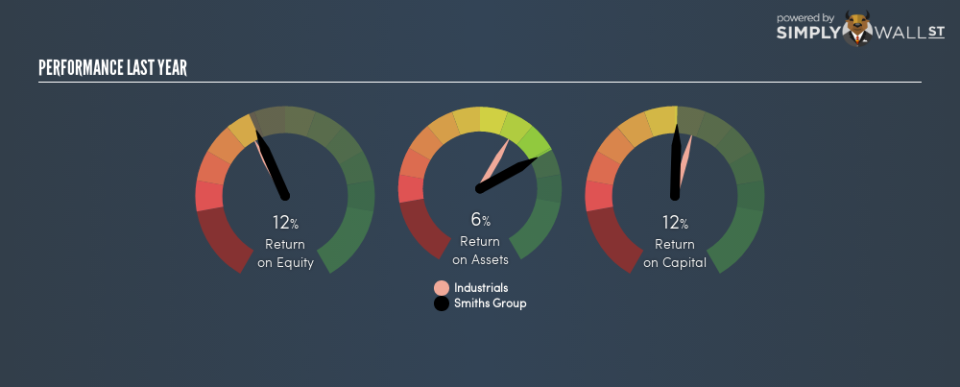Smiths Group plc (LON:SMIN) Might Not Be A Great Investment

Today we’ll look at Smiths Group plc (LON:SMIN) and reflect on its potential as an investment. Specifically, we’ll consider its Return On Capital Employed (ROCE), since that will give us an insight into how efficiently the business can generate profits from the capital it requires.
First of all, we’ll work out how to calculate ROCE. Next, we’ll compare it to others in its industry. And finally, we’ll look at how its current liabilities are impacting its ROCE.
What is Return On Capital Employed (ROCE)?
ROCE measures the amount of pre-tax profits a company can generate from the capital employed in its business. In general, businesses with a higher ROCE are usually better quality. In brief, it is a useful tool, but it is not without drawbacks. Renowned investment researcher Michael Mauboussin has suggested that a high ROCE can indicate that ‘one dollar invested in the company generates value of more than one dollar’.
How Do You Calculate Return On Capital Employed?
The formula for calculating the return on capital employed is:
Return on Capital Employed = Earnings Before Interest and Tax (EBIT) ÷ (Total Assets – Current Liabilities)
Or for Smiths Group:
0.12 = UK£514m ÷ (UK£5.2b – UK£961m) (Based on the trailing twelve months to July 2018.)
So, Smiths Group has an ROCE of 12%.
See our latest analysis for Smiths Group
Want to help shape the future of investing tools and platforms? Take the survey and be part of one of the most advanced studies of stock market investors to date.
Is Smiths Group’s ROCE Good?
One way to assess ROCE is to compare similar companies. Smiths Group’s ROCE appears to be substantially greater than the 9.5% average in the Industrials industry. We consider this a positive sign, because it suggests it uses capital more efficiently than similar companies. Regardless of where Smiths Group sits next to its industry, its ROCE in absolute terms appears satisfactory, and this company could be worth a closer look.
It is important to remember that ROCE shows past performance, and is not necessarily predictive. ROCE can be deceptive for cyclical businesses, as returns can look incredible in boom times, and terribly low in downturns. ROCE is only a point-in-time measure. What happens in the future is pretty important for investors, so we have prepared a free report on analyst forecasts for Smiths Group.
What Are Current Liabilities, And How Do They Affect Smiths Group’s ROCE?
Current liabilities are short term bills and invoices that need to be paid in 12 months or less. Due to the way ROCE is calculated, a high level of current liabilities makes a company look as though it has less capital employed, and thus can (sometimes unfairly) boost the ROCE. To counteract this, we check if a company has high current liabilities, relative to its total assets.
Smiths Group has total assets of UK£5.2b and current liabilities of UK£961m. Therefore its current liabilities are equivalent to approximately 19% of its total assets. Low current liabilities are not boosting the ROCE too much.
Our Take On Smiths Group’s ROCE
Overall, Smiths Group has a decent ROCE and could be worthy of further research. You might be able to find a better buy than Smiths Group. If you want a selection of possible winners, check out this free list of interesting companies that trade on a P/E below 20 (but have proven they can grow earnings).
I will like Smiths Group better if I see some big insider buys. While we wait, check out this free list of growing companies with considerable, recent, insider buying.
To help readers see past the short term volatility of the financial market, we aim to bring you a long-term focused research analysis purely driven by fundamental data. Note that our analysis does not factor in the latest price-sensitive company announcements.
The author is an independent contributor and at the time of publication had no position in the stocks mentioned. For errors that warrant correction please contact the editor at editorial-team@simplywallst.com.

 Yahoo Finance
Yahoo Finance 
